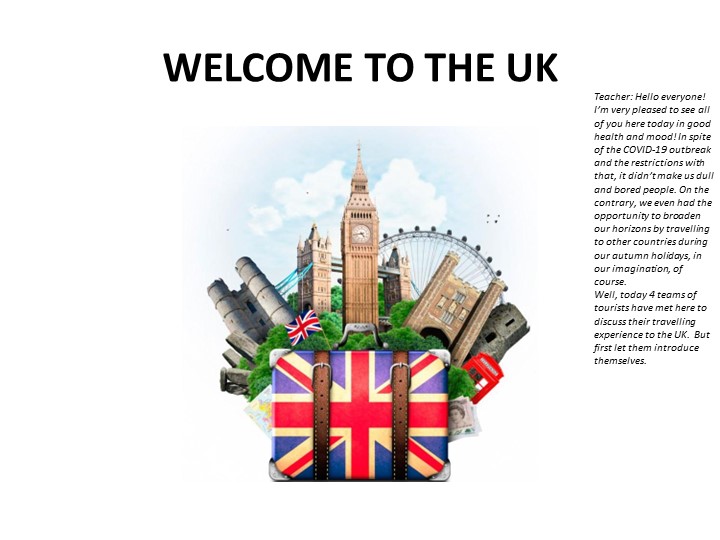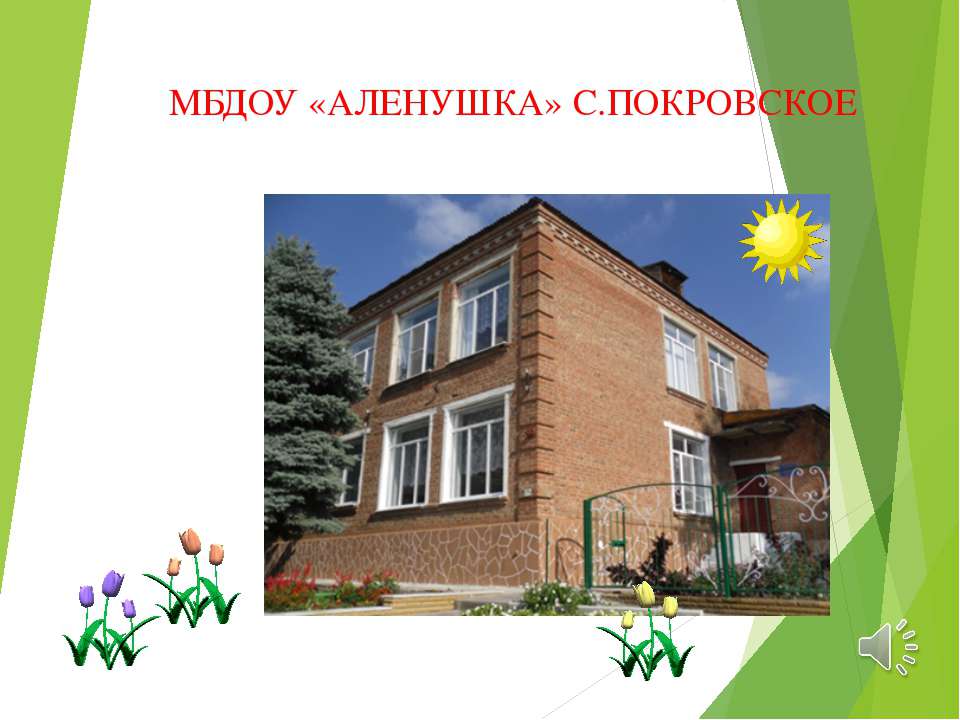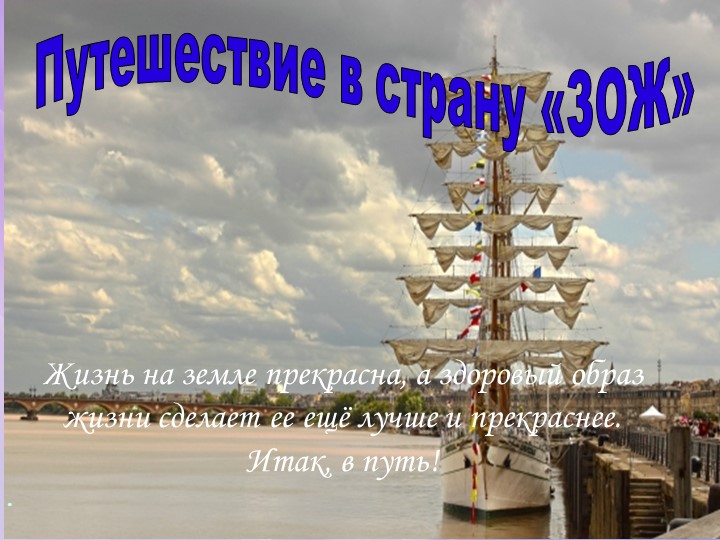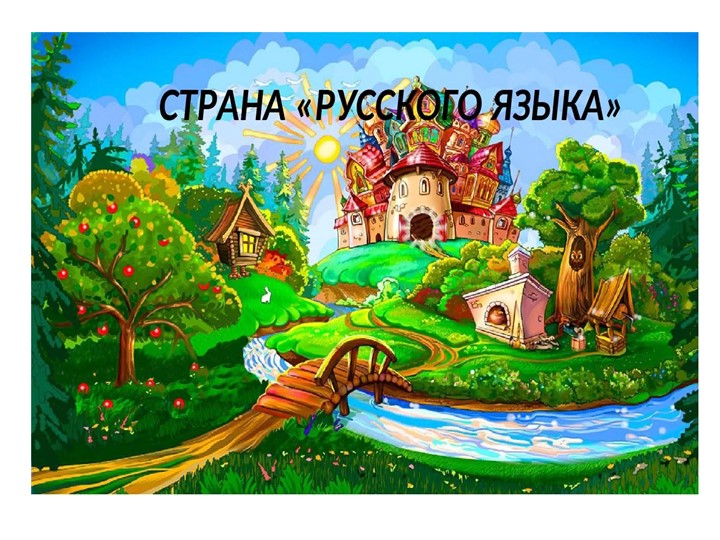Презентация к внеклассному мероприятию по английскому языку на тему " Путешествие за границу. Добро пожаловать в Великобританию"

- Рубрика: Презентации / Другие презентации
- Просмотров: 288
Презентация "Презентация к внеклассному мероприятию по английскому языку на тему " Путешествие за границу. Добро пожаловать в Великобританию"" онлайн бесплатно на сайте электронных школьных учебников edulib.ru
WELCOME TO THE UK
Teacher: Hello everyone! I’m very pleased to see all of you here today in good health and mood! In spite of the COVID-19 outbreak and the restrictions with that, it didn’t make us dull and bored people. On the contrary, we even had the opportunity to broaden our horizons by travelling to other countries during our autumn holidays, in our imagination, of course.
Well, today 4 teams of tourists have met here to discuss their travelling experience to the UK. But first let them introduce themselves.
Winchester, England
Student 1: Hello. My name ... And these are my friends: .... We’ve just returned from Winchester, one of the oldest cities in England, earstwhile the capital of the country. British people celebrate some festivals like Christmas and Easter with the rest of Europe but some are just British. Here is a very British festival and a very noisy one.
November, 5th
Bonfire Night (Guy Fawkes Night)
Student 2: It’s November the 5th, Bon fire Night or Guy Fawkes Night, that is very special. It is celebrated in towns and cities across Britain. So that night we also took part in the celebration in the city centre by the Guild Hall, where a torch-lit procession of thousands and thousands of people followed a band through the city to burn a ragdoll called “Guys” and to watch the fireworks.
A man called Guy Fawkes planned to kill King James. It was called the Gunpowder Plot.
Student 3: You know, it’s not only about fun. It is about history, as well. Four hundred years ago, a man called Guy Fawkes planned to kill King James by blowing up the Houses of Parliament. It was called the Gunpowder Plot. It failed, and to mark the event such rag dolls ‘Guys’ are burnt on the bonfire and fireworks are set off. Fireworks are made using gunpowder
Colourful fireworks
Student 4: There were about four thousand fireworks which all created different effects. They were really good and they were really colourful and they looked really cool. We all liked this festival and even have learnt a little poem on that holiday .
Remembrance Day, November,11
Teacher: Thank you, guys! That was really amazing. You know, speaking about the holidays that are somehow memorial days, we can’t miss the 11 th of November. Well , yesterday was Remembrance Day, Veterans Day or Poppy day. That’s why I’ve pinned on a poppy brooch. Remembrance Day has been observed since the end of the First World War to remember the British soldiers that have died in wars. Today millions of poppies are sold and worn by people in Great Britain, and money goes to the charity helping the war veterans.
Edinburgh, Scotland
Teacher (addressing to another group of students) : Guys, what about you? Where did you go?
Student 5. Hello! Nice to meet you! In August we visited Scotland. We were happy to participate in the Royal Edinburgh Military Tattoo parade.
The Royal Edinburgh Military Tattoo
Teacher: Why is it called so? Is there anything in common with ink tattoos with which people decorate their bodies?
Student 6. Of course not. The word tattoo is the old Dutch word describing the last duty call of the day performed by military musicians.
A tattoo parade performed by military musicians
Teacher: So, as far as I can understand the Royal Edinburgh Military Tattoo is an annual festival performed by British Armed Forces and international military bands, right? And where did it take place?
Student 7: It was on the Esplanade of Edinburgh Castle in the capital of Scotland. There were different military bands. But these pipers from the massed pipes and drum orchestra were the best ever seen.
Dancers and fireworks at the end
Student 8: There were also many dancers, motorcyclists and a set off the fireworks at the end. It was fantastic!
Symbols and Patrons
Teacher: Guys, your each group has got a special brooch on the chest of a group leader as a national symbol of a country you represent. Every country has its own unique symbols. They can be places, things, flowers and even people. So called Patron saints are in many ways an extension of this symbolism, each an important person not only for Christianity but for the country which he patronizes.. The Tudor red rose is a national symbol of England with St. George as patron. The thistle is the symbol of Scotland with St. Andrew the Apostle. And , by the way, in two weeks, on the 30th of November is Saint Andrew’s Day and is also a national holiday in Scotland. Despite having never stepped foot in Scotland while alive, When he died, his relics were sailed across the sea from Greece and buried in Scotland, in a town now called Saint Andrew’s. The Scottish flag is even inspired by Saint Andrew and is called the Saint Andrew’s Cross. On Saint Andrew’s Day schools across Scotland hold special events to celebrate, such as meals, singing, dances, storytelling and Scottish poetry readings. The day is often celebrated with family and friends with traditional Scottish food and traditional Scottish musical instruments such as the bagpipes. And what about the shamrock? Can you guess from what country this team has arrived?
Belfast, Northern Ireland
-Northern Ireland. . (in choirs)
And what is the patron saint of Northern Ireland?
-Saint Patrick. (in choirs)
St. Patrick’s Day
Student 9: Once in March we visited Belfast. My name is... An Irish policeman invited us to see the nearby parade for Saint Patrick's Day. He told us, 'It's a great day for the Irish.' But we aren’t –we said, - and the policeman replied, 'You don't have to be Irish to be Irish!' Saint Patrick's Day is the national day of Ireland.
Student 10: 2. This holiday is celebrated around the world by millions of people, Irish and not-so-Irish. The most famous activities on Saint Patrick's Day are the parades.
Shamrock brooches
Student 11: These are carnivals, where people dress up and walk along the street, dancing or playing music. People wear shamrock brooches on their chests with much pride as a symbol on St. Patrick’s Day.
the Irish harp (Clarsach)
Is the official symbol of Ireland
Teacher: This clover is one of the most widely recognized symbols of Ireland and is often referred to as the unofficial symbol of this country. The official symbol is actually the Irish harp instead. But what country does the daffodil belong to?? What other symbols do you know?
-Wales. (in choirs)
Red dragon and a leek. (in choirs)
Teacher: Good of you. So guys, be so kind to tell us everything you want about that gorgeous country.
Cardiff, Wales
Student 12:Hello. My name is...And we also managed to visit the festival. But in Cardiff, Wales. Traditionally in Wales on the first of March they all get dressed up in authentic Welsh costumes.
The girls wear daffodils, the boys wear leeks
Teacher: Why?
Student 13:There are several legends. One is that Saint David told his troops to wear leeks on their helmets to help them identify themselves. And I know they fought in a field of leeks. So as a reminder of their bravery and loyalty, the Welsh began to wear leeks in their caps on Saint David’s Day.
Teacher: What about the daffodil then?
Student 14. Well, the daffodil appeared in the spring on the 1st of March.
Welsh Prime Minister Lloyd George wore it and encouraged others to do the same.
It soon became another national emblem of Wales. –Teacher: Thank you guys! It was very interesting! Hope you liked to imagine travelling!

























